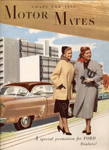
Student & Teacher Resources
Femininity and the Electric Car
1. How did stereotypes of men and women differ in the late nineteenth and early twentieth century? How did these stereotypes influence views of who should drive electric versus gasoline-powered cars?
2. Scharff writes that the electric car’s “association with women was at once a symptom of, and an attempted cure for, its competitive disadvantages.” What does she mean by this?
3. What do historians mean by the concept of “separate spheres”? How does Scharff apply it to the early notions about automobiles?
4. Why did makers of electric cars try to appeal to men as well as women if the electric was seen as particularly suited to women? Did men respond to these appeals?
5. What were some of the important disadvantages of the electric car? How did these contribute to the electric’s failure to appeal to women as well as men?
6. Why did makers of gasoline-powered cars try to appeal to women if the gasoline car was seen as particularly suited to men? Did women respond to these appeals?
7. Scharff argues that “[t]he surprising thing . . . is not that electrics faded so early, but that they lasted so long.” Why is it surprising that electric cars lasted so long?
8. In what ways do the figures in Scharff’s Table 2 support her claims about the electric car?
1. Do stereotypes exist today about women’s ability to drive, buy, fix, or customize cars?
2. Are certain cars today associated with women? If so, which ones? What characteristics make them so?
3. Early auto writer C. H. Claudy claimed that “women naturally choose those cars the interior appointments of which please them the most.” Based on your experiences, do women today pay more attention to a car’s interior than men do?
1. David Gartman argues in “Tough Guys and Pretty Boys” that it was General Motors in the 1920s that turned the auto industry’s attention to the “feminine” realm of style, color, “look,” etc. Does Scharff’s account of the electric car reinforce Gartman’s argument? Contradict it? Supplement or qualify it?
2. Martin Melosi discusses the competition between gasoline, electric, and steam cars in the early twentieth century. Does he concur with Scharff’s account of the electric’s failure? Does Scharff discuss factors or details behind the electric’s failure that Melosi does not consider? Does Melosi discuss factors or details behind the electric’s failure and gasoline’s success that Scharff does not consider?
3. How might the concept of “separate spheres” be applied to Stephen Meyer’s discussion of gender issues among autoworkers in the 1920s and 30s?
1. Take a closer look at the ad for the 1931 Ford roadster. Does this ad confirm Scharff’s argument that women, too, wanted power, speed, and range in a car? Does it also invoke stereotypes about women’s desire for style, comfort, beauty, and luxury?
2. Scharff writes at the end of her essay that even though the efforts to make the electric car a “woman’s” car and the gasoline car a “man’s” car failed, “we should be wary of declaring a victory . . . for the power of the automobile over the stubbornness of gender ideology.” Analyze the ads for the 1925 Ford, 1928 Chrysler, and 1949 Ford. Could Scharff point to these ads to support that claim? How and in what ways?
3. Examine two articles on women’s driving fashions from The Ladies Home Journal in 1911 and 1915, “When You Go Driving or Automobiling” and “When You Go Motoring.” What do these articles reveal about that nature of driving in this period, and especially about women and driving? Do they complement or contradict the car ads and motoring articles that Scharff discusses throughout her essay?
1. Analyze a number of modern automobile ads, comparing them to the early ads that illustrate Scharff’s essay, to investigate whether and how automakers aim their advertisements to women. Do any do so as directly as the early ads for the electric car? As the early ads for gasoline-powered car from the 1910s through the 1930s that address themselves to women? Do modern ads appeal to women in any way? If so, how? Do ads for certain types of cars seem to be directed more at women than ads for other types? Be sure to pay attention to both the text or spoken material of the ad and its pictures or visual material.
2. The electric car has reappeared in the marketplace in recent years in the form of the gas-electric hybrid vehicle, first with the Toyota Prius and Honda Insight, then with hybrid versions of existing models like the Honda Civic and the Ford Escape. Research the introduction and marketing of one or more gas-electric hybrids. Are there any signs that these vehicles are aimed, directly or indirectly, at women more than men?
For other Resources on Gender see:
Gender and Automobility in the United States
Femininity and the Electric Car
About the Project | Credits | Contact Us | Student & Teacher Resources | Site Map
©2004-2010 Automobile in American Life and Society
